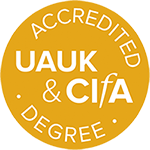
Using airborne lidar (Light Detection and Ranging), it is possible to map all the upstanding features in the landscape. The lidar sends out a scanning laser beam from the aircraft, which is reflected back to the sensor by the earth's surface and the features on it. The time this takes is used to calculate the exact distance from the aircraft. The surface height is derived from knowing the aircraft's exact location and attitude, which are obtained from differential GPS and inertial navigation system measurements.
The lidar data was collected using the Unit for Landscape Modelling's Optech ALTM 3033 sensor. The OSi passage station used is in Kells Community School.
Points were collected across a 5 x 6 Km survey, at an average ground spacing distance of 60 cm, a total of 83 million points. These points are then interpolated to create a Digital Surface Model.

The lidar surface can be shaded from any azimuth and elevation. The advantages of low oblique lighting when photographing earthworks are well known. Greater flexibility is possible when illuminating the digital surface, including illumination angles which do not occur naturally.

The sensor records the intensity of the reflected laser beam. This image shows the variations in the surface reflection characteristics. Trees, stone and roads are dark and grass is pale in tone.
© 2004 Corinne Roughley and Colin Shell


